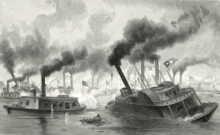Battle of Memphis
The battle of Memphis was a naval battle between ships of the Union army and the Confederates in the American Civil War on June 6, 1862 just above Memphis (Tennessee) on the Mississippi River . It ends with a complete victory for the Union.
The Union Army had set up a fleet of ramming ships ( United States Ram Fleet ) and ironclad ships under the command of Colonel Charles Ellet and the flag officer Charles Henry Davis . The gunboats belonged to the Mississippi River Squadron commanded by Davis, the ramming ships were rearranged under the command of the civil engineer Charles Ellet. On the Confederate side, Captain James E. Montgomery and Brigadier General M. Jeff Thompson (the commander of the land forces ) were in command. Montgomery and the other captains had previously been river boat captains on the Mississippi in their civilian life. The Confederate River Defense Fleet was originally set up in New Orleans and consisted of 14 ships, but half remained in New Orleans to defend the city against attacks by Admiral David G. Farragut . They were destroyed there in April 1862 after the Farragut attack on New Orleans.
After the Confederates defeated the Union Ironclads at Plum Run Bend in Tennessee on May 10, 1862 , they withdrew to Memphis. After the conquest of Corinth (Mississippi) by the Union General Henry W. Halleck , the strategic importance of Memphis was greatly diminished because the rail links to the rest of the Confederation were cut. General PGT Beauregard had therefore withdrawn troops from Memphis and, for example, relocated them to Vicksburg (Mississippi) . The Confederate fleet was supposed to go to Vicksburg, too, but ran out of coal. They had the choice to destroy their fleet or to fight and decided to fight.
The Union fleet attacked at 5.30 in the morning and the sea battle lasted only an hour and a half. The course could be observed on land by the civilian population in Memphis.
The Ironclads Benton (the flagship of Davis), Louisville, Carondelet, Cairo and St. Louis and the ramming ships Queen of the West (commanded by Charles Ellet), Monarch, Lancaster and Switzerland were involved on the Union side . The Confederates had the piling ships General Beauregard, General Bragg, General Price, General Van Dorn, General Thompson, Colonel Lovell, General Sumter and Little Rebel. As some of them were protected against bombardment with cotton padding, some of them were also called cottonclads . All Confederate ships except General Van Dorn, which escaped in the Yazoo River , were captured or sunk. The Queen of the West opened hostilities by ramming CSS Colonel Lovell, was rammed in turn and was no longer operational after the battle.
Charles Ellet was wounded in a pistol shot and died soon after in a hospital. He was the only victim on the Union side. Ellet was actually an engineer and the battle was the last time a civilian with no prior military experience was in command of a naval battle in the U.S. Forces.
Memphis surrendered to Union forces immediately after the battle. After the battle, there was no significant Confederate fleet presence on the Mississippi. However, it took a while until the Union Army conquered the Mississippi with the conquest of Vicksburg in July 1863. The Ellet ramships remained in action but were used for amphibious operations under the command of Alfred W. Ellet (Mississippi Marine Brigade), brother of Charles Ellet and later brigadier general.
The battle is sometimes called the First Battle of Memphis . A second engagement took place in April 1864 when Nathan Bedford Forrest undertook a failed nightly cavalry attack (raid) to free prisoners in Memphis and to take Union generals prisoner.

